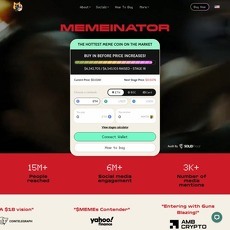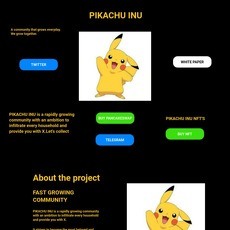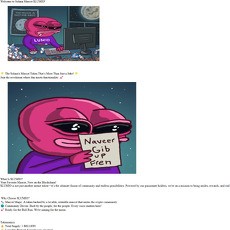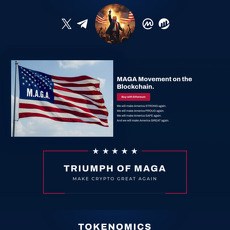CAGA Review
CAGA
cagacrypto.com
If your website is on the scam list and you think that you are not a scammer, contact us. After you provide us with all the proof that you are in Crypto World with good intentions, we will delist you. Usually, you get in this category because you are hiding your team, you have a bad reputation(you are tricking, deceiving, scamming people), and you haven't got a written project whitepaper or is a shitty one....
Their Official site text:
1️⃣ Introduction
Duplicate
Search pages
Crypto Asset Governance Alliance (CAGA) Whitepaper
1️⃣ Introduction
2️⃣ CAGA Crypto Platform
3️⃣ Tokenomics
4️⃣ Governance and Voting - CAGA DAO
5️⃣ Staking Mechanism
6️⃣ Liquid Staking Assets - dive into cgETH and cgCAGA
7️⃣ Roadmap
1️⃣
Introduction
Last Updated:
5 days ago at 8:57 am
Welcome to Crypto Asset Governance Alliance (CAGA) - ecosystem, where we shape the financial landscape of tomorrow
In a world where financial independence and self-governance are the keys to unlocking boundless possibilities, CAGA plays the role of a trusted companion on this journey. At its core, CAGA is a truly decentralized autonomous organization (DAO) that thrives on the principles of community-driven governance, innovation, and financial inclusivity.
At CAGA, we envision a financial ecosystem where every participant has a voice, a stake, and the power to shape the future.
Let's imagine! Imagine a platform where every voice counts, where every stakeholder has a say in the collective decision-making process. That’s what CAGA brings to the table. By connecting the idea of DeFi governance with liquid staking mechanisms, CAGA creates a new experience for crypto enthusiasts and visioners.
With CAGA, you’re not just a passive investor, but an active participant in a growing ecosystem. Every proposal, every vote, and every discussion is a step towards a more transparent and equitable financial future.
And the beauty of it?
It’s all built on the rock-solid foundation of the Ethereum blockchain, ensuring security, transparency, and trust!
CAGA is not just a project; it’s a movement. It’s about harnessing the collective power of a community to steer the ship of innovation in the cryptocurrency landscape. And it all starts with CAGA’s native tokens and its unique staking mechanism. When you stake your assets in CAGA, you’re not just earning rewards; you’re earning a stake in a governance model that values your input and rewards your engagement.
Step into the world of CAGA, where your ideas are valued, your investments are rewarded, and your voice is heard. Together, let’s redefine what’s possible in the decentralized financial domain, one stake, one vote, and one innovation at a time!
The Team behind CAGA
Meet the team behind our DAO, a dynamic group of visionaries leading the charge in the world of blockchain and decentralized finance. Founded by early-adopters of cryptocurrencies, with years of experience building and trading in Web3. Our passion for decentralization and boundless enthusiasm sparked the creation of our DAO, setting the stage for innovation.
Under Rino’s expertise - he construct the technical architecture and software landscape to ensure seamless and secure operation. With Ed.’s wealth of experience, we are guided through complex crypto landscapes and keeps us compliant. JLB, the creative force within our team, the PR/Marketing responsible for driving our project's visibility and success together, these governors share a vision of empowerment and transformation in the crypto space. VG the powerhouse behind our expansion, constantly gathering the best inputs for the better interest of CAGA. Last but not least, Wilson is the master collaborator, forging connections that open new doors for our community.
CAGA Crypto Platform
Last Updated:
6 days ago at 12:18 pm
I. Proof of Stake and the Merge
Proof of Stake (PoS) is a consensus algorithm used by blockchain networks to achieve distributed consensus. Unlike the Proof of Work (PoW) algorithm used by networks like Bitcoin, PoS relies on the amount of crypto held by a network participant to determine their ability to create a new block on the blockchain. PoS is a way more energy-efficient, ecological and scalable compared to PoW
The Merge refers to an event when Ethereum mainnet (PoW) merged with the Ethereum 2.0 Beacon Chain (PoS), transitioning from a PoW to a PoS consensus mechanism.
Since being merged in September 2022, Ethereum has a Proof of Stake (PoS) chain called the Beacon Chain, which is faster, more energy efficient and more decentralised than PoW. It's powered by users depositing ETH and providing an Ethereum node online 24/7 to perform the required validation.
As a reward for providing the node, the Beacon Chain gives node operators additional ETH on top of their deposits. It can be viewed similarly to earning interest in a bank account, with the exception that these rewards are generated in return for helping secure the network.
II. What is liquid staking? Why it's important?
Liquid staking plays a crucial role in the decentralized finance (DeFi) ecosystem by unlocking the liquidity of staked assets (like ETH). It enhances capital efficiency and improves liquidity: two pivotal points for the growth and stability of DeFi.
According to Messari, more people are now using liquid staking. Statistics indicates that the supply of liquid staking tokens like stETH and wstETH is emerging, making them more common in Ethereum's DeFi world. Over a year, the amount of top liquid staking platforms has grown from 15% to 32.7%, showing the strong growth. This area has shown steady growth all year.
In lending, there's been a big growth in total value because people are borrowing stable assets like USDC/ETH while depositing assets that earn them rewards like sDAI and stETH. This tactic, known as 'folding', stays profitable as long as the cost of borrowing stays lower than the rewards earned. For instance, this strategy led to a big $300 million growth in total lending value just in September 2023.
Simply, liquid staking allows users to stake tokens and simultaneously use them in complex DeFi ecosystem. This is made possible by wrapping the staked tokens and providing users with a wrapped token that is a claim on the underlying collateral.
The wrapped tokens can be transferred and generate yield
Liquid staking permits users to stake and unstake their coins without being beholden to a lock-up period. Furthermore, liquid staking enhances network security on PoS chains.
Through liquid staking derivatives, users can represent their staked assets, enabling them to participate in DeFi activities and earn additional yields on top of their staking rewards. As of 2023, liquid staking protocols contribute to more than 31% of the total value locked in DeFi, indicating the significant impact and adoption of liquid staking solutions.
1) What does CAGA do?
CAGA Crypto emerges in this landscape as an Ethereum Proof of Stake Protocol and Decentralized Autonomous Organization (DAO), engineered to be community-owned, decentralized, trustless, and harmonious with staking in Ethereum. The core premise behind CAGA is to ensure the network remains impartial to any single entity, fostering a democratic ecosystem where the power truly belongs to the community.
2) What is CAGA's mission?
CAGA's goal is to make it easy for people to participate in blockchain decisions, while keeping their investments flexible. When you join CAGA, you become part of a community, get to vote on important decisions like which networks to join, and help shape the future of the project. This gives everyone a voice and makes the CAGA community more valuable.
CAGA plans to overcome the usual hurdles of traditional staking methods by having a strong plan in DeFi (Decentralized Finance) that focuses on community-driven initiatives be it takeover, creating new Apps or collaborating with other projects, as long as community vote through CAGA will work on it. This new approach aims to solve the common problems of staking such as liquidity and ease of access, making it more attractive and useful to a wider range of people.
CAGA showcases a clear governance model that makes decision-making open and fair. Stakeholders have a real voice and are involved in important decisions, such as connecting with other networks, by submitting and voting on ideas.
3) How CAGA addresses the current challenges
Traditional staking often locks up people's assets, preventing them from using or moving them, which can discourage many from participating. To address this, CAGA Crypto has built a strong system that offers better solutions in liquid staking and community-led governance.
CAGA's approach to liquid staking helps get around this lock-up problem by issuing Liquid Staking tokens (such as cgCAGA, cgETH) that represent the staked assets. This allows stakers to maintain their flexibility and participate in other DeFi activities without having to unstake, making the staking ecosystem more open and fluid. It also sets up a flexible governance model where the community can have a say in decisions.
Making It Easy for the Community
A lot of platforms out there can be tough to navigate for people wanting to have a say in governance. CAGA makes this easier with a user-friendly interface where anyone holding or staking CAGA governance tokens can effortlessly put forth new ideas or vote on existing ones. This simplified approach encourages more people to get involved in governance, leading to wider community participation in decision-making.
Open Decision Making
CAGA brings an open and fair decision-making process through DAO. Every idea and vote is out there for the whole community to see, along with clear updates on the status and results of each proposal. This openness builds trust, a sense of community ownership, and accountability, which are crucial for keeping the platform thriving in the long run.
Cross-chain Opportunities (TBD, under development)
One of the great things about CAGA is its bridge to other networks, broadening the complex ecosystem and its ability to work with others. By getting the community's input on which networks to connect with, CAGA hopes to contribute to a more interconnected and versatile DeFi sphere.
4) CAGA DAO: governance and voting
Through CAGA's decentralized governance, individuals get to play a big part in how the project grows, creating a community-focused environment where everyone's opinion counts.
The cornerstone of CAGA's operational ethos lies in its DAO. This section delves into the intricacies of governance and voting within the CAGA DAO, elucidating how proposals are created, debated, and decided upon.
Proposal creation
Initiation. Any holder or CAGA staker can initiate a proposal.
Drafting. Proposers select a category, add a title, and draft the body text of the proposal.
Submission. A 50000 CAGA will be required to list the proposal on-chain. If a proposer lacks the necessary funds, they can purchase from the various platform CAGA token is listed on.
Listing. Once submitted, the proposal is listed on-chain and moves to the voting period, which lasts for 30 days.
Voting process
Eligibility. To vote on a proposal, one must have at least 0.01 voting power, which is obtained by staking CAGA governance tokens. Voting power is dependent on the staking amount.
Voting. Eligible voters can cast their vote as 'FOR' or 'AGAINST' the proposal directly on the governance page, add comments and argue against.
Transparency. All voting activities are transparent and can be viewed by the community, including:
ETH address of voters
Vote details
Voting power
Token holdings
Comments
Total number of votes
Decision Making. Post the voting period, the decision is taken based on the majority vote. If approved, the proposal moves to the 'Proposal Queued' status and eventually to the 'Execution' status. If rejected, a 'Proposal Rejected' status is displayed along with feedback from core members regarding the rejection.
Governance framework of CAGA is designed with a safety net to ensure the project's integrity and long-term sustainability. The option to reject a proposal, even if it initially passes through, is a critical mechanism to prevent any potential harm to the project.
Proposal status lifecycle
Draft Created
Published On-Chain
Voting Period Started
Voting Period Ended
CAGA's commitment to decentralizing power and giving the community a real voice is evident in the way CAGA's DAO governance and voting works. It's all about making decision making a team sport and building a culture where everything is out in the open and everyone is encouraged to participate. This approach is key to CAGA's long-term success and growth.
5) CAGA staking mechanism
CAGA's staking setup makes it easier for more people to get involved by lowering the usual hurdles seen in staking. When you stake CAGA governance tokens or Ethereum (ETH), what you get back are Liquid Staking tokens (cgCAGA or cgETH). Tokens are the wrap of the assets you staked and they're your ticket to the broader DeFi world.
Staking at CAGA isn't just a feature, it's a cornerstone and the main purpose of the platform. It's all about letting folks stake their assets, get Liquid Staking tokens and rewards in return. The whole idea is to create a staking experience that's inviting, secure, and rewarding.
Let’s dive deeper into how CAGA’s staking setup works
6) Networks and tokens
CAGA operates on Ethereum
Ethereum: Supports staking of Ethereum (ETH) and CAGA governance tokens;
Tokens APR
ETH: Users can stake Ethereum to earn a competitive APR rate (Kindly refer to dApps www.cagacrypto.com for latest APR rate).
CAGA: Staking CAGA governance tokens grants users with emission of 3 Billion in the first year, followed by 2 Billion on second year and 1 Billion on the third year (365 days). Subsequent years will be decided through community proposals and votes. (Kindly refer to dApps www.cagacrypto.com for latest APR rate).
DISCLAIMER NOTE
APR is subjected to market conditions and always refer to www.cagacrypto.com for the latest APR rate.
7) Liquid Staking tokens (read more here Untitled)
Liquid Staking assets are a cornerstone of DeFi landscape. This is a real bridge between staked assets and liquid markets. In CAGA ecosystem, three primary Liquid Staking assets stand out: cgETH and cgCAGA. These tokens are signifying your stake in the respective networks while allowing you to interact with the DeFi space without closing your staked position.
When users stake their assets, they receive Liquid Staking tokens as a representation of their staked assets
cgETH: Issued when staking ETH;
cgCAGA: Issued when staking CAGA governance tokens.
Liquid Staking tokens can be used within the DeFi ecosystem, providing liquidity and enabling participation in other DeFi activities without requiring users to un-stake their assets.
8) Unstaking and reward claiming
Users can un-stake their assets at any time, subject to the blockchain queue. Upon un-staking, the corresponding Liquid Staking tokens are burned, and users receive their staked assets back along with the accrued rewards.
After that, they can easily claim their rewards, which are subject to a 10% reward fee. This fee will be sent to treasury for maintenance of the DAO, which enables long-term community success and ensures that the funds are used according to the DAO's mission and objectives.
The claim history is transparently displayed, showing past, pending, and claimed rewards.
III. CAGA Liquid Staking assets
When you stake with CAGA, you receive Liquid Staking tokens such as cgCAGA and cgETH. These aren't just placeholders for your staked assets, they're your passport to more financial adventures in the DeFi world, all without having to unstake your assets.
These Liquid Staking tokens open doors to more opportunities to grow your holdings, making staking with CAGA not only safe, but potentially a smart move to increase your returns
Staking formulas we use in CAGA
1) Liquid Staking token issuance
Example: If a user stakes 10 ETH and the staking ratio for ETH is 1:1, then 10 cgETH will be issued.
2) Rewards calculation
Example: If a user stakes 10 ETH at an APR of 3.4% for 30 days, the rewards earned would be 0.0279 ETH.
3) Reward claiming
Example: With a 10% reward fee (this fee will be sent to the treasury for maintenance of the DAO), the rewards to be claimed from the above example would be 0.0251 ETH.
4) Unstaking
Example: The total return from the above example would be 10.0251 ETH.
5) Voting power
For every CAGA token staked, you earn 0.01 Voting Power every day (24 hours)
Example: If a user stakes 1000 CAGA and then then the voting power would be 10.
6) Annual rewards
Example: If you stake 100 ETH at an APR of 3.4%, your annual rewards would be:
100 × 0.034 = 3.4 ETH
IV. Why engage with CAGA?
CAGA is a place where governance, staking and DeFi innovation come together to overcome current hurdles and open new horizons on the Ethereum blockchain.
Joining CAGA comes with a bouquet of benefits. Here are several reasons why you should engage with CAGA:
1. Liquidity through Liquid Staking Tokens
2. Clear and Transparent Governance
3. Enhanced Security and Transparency
4. Community-Centric Development project
5. Cross-chain and Interoperability with other protocols (TBD)
CAGA Crypto is not just a liquid staking platform. It's a community-led project that aims to reshape the landscape of decentralized governance and staking.
CAGA is about creating a collaborative space where collective decision-making drives innovation, and every member has a fair shot at influencing the project's path
Tokenomics
Last Updated:
5 days ago at 12:19 pm
Contract Address :
0xbddc20ed7978B7d59eF190962F441cD18C14e19f
etherscan.io
https://etherscan.io/address/0xbddc20ed7978B7d59eF190962F441cD18C14e19f
Governance Wallet Address:
0x5BaCb1D4FcEFB11da92c05C60d1DdcdEd2215883
etherscan.io
https://etherscan.io/address/0x5bacb1d4fcefb11da92c05c60d1ddcded2215883
Treasury Address:
0x52659d424f52132ba56f96F0Fcf04ab5d40af12d
etherscan.io
https://etherscan.io/address/0x52659d424f52132ba56f96f0fcf04ab5d40af12d
Burnt LP Hash:
0x849fbfb2f2b1699da2249b23686328992c47e4e63299fe96c06d973ba19667f2
etherscan.io
https://etherscan.io/tx/0x849fbfb2f2b1699da2249b23686328992c47e4e63299fe96c06d973ba19667f2
1. Token distribution
The total supply of CAGA tokens is 100 Billion. The distribution is structured as follows:
Liquidity pool to Uniswap V2
Allocation: 79%
Tokens: 79 Billion CAGA
Ensuring Fairness and Transparency. CAGA DAO members have the potential to partake in a governance system that is more effective, transparent, and responsible. By deploying 79 Billion CAGA tokens to the public, it ensures the development of a stronger community. After the Liquidity Pools has been created, the LP token will be burned to ensure fairness and decentralisation.
CEX liquidity
Allocation: 8%
Tokens: 8 Billion CAGA
Centralized exchange will allow massive outreach to grow the community. CAGA allocates token for use in centralized exchanges (CEX) for liquidity purposes ensuring adequate liquidity at all times, our goals is to reach for as many communities as possible by listing at Tier 1 and Tier 2 exchanges.
Emission
Allocation: 6% (over 3 years - 365 Days x 3)
1st Year - 3% - 3 Billion CAGA
2nd Year - 2% - 2 Billion CAGA
3rd Year - 1% - 1 Billion CAGA
Subsequent year emission rewards will be decided through proposal (votes by the community)
From 4th year onwards or any time through votes, you get to cast a vote to decide on the CAGA rewards, which would be exciting to imagine on the possibilities the community can decide on.
Treasury
Allocation: 5%
Tokens: 5 Billion CAGA
Our treasury will grow and benefit the community. The growth happens through various means. We would collect fees from projects, such as loan fees, governance proposals fees or protocol fees. The community would also gain returns on investments in projects approved by the community such as the Staking Project, Mega Pool, Swap Pool - DEX and many more. This includes other assets (other token) that CAGA may hold moving forward with the involvement in other projects.
Governance management
Allocation: 2%
Tokens: 2 Billion CAGA
Governance Management are always working for the goals of the community.
Governance management 2% allocated tokens will not be sold. The governance management will only receive rewards through staking, or future tokens/rewards that yield from collaborations, future projects and so on.
2. Mathematics behind staking rewards
The formula to calculate the annual staking rewards for an individual
Example: If a user stakes 10 Million CAGA and the total staked amount is 20 Billion CAGA,
CAGA's tokenomics is carefully structured to support a stable, sustainable ecosystem. The clear allocation of tokens, coupled with well-defined metrics and mathematical formulas, creates a solid foundation for the growth and evolution of the CAGA platform. Tokenomics reflects a mixture of economical sustainability and user-centric incentives, which makes it a powerful feature of the CAGA project
Governance and Voting - CAGA DAO
Last Updated:
5 days ago at 4:15 pm
Contract Address :
0xbddc20ed7978B7d59eF190962F441cD18C14e19f
etherscan.io
https://etherscan.io/address/0xbddc20ed7978B7d59eF190962F441cD18C14e19f
Governance Wallet Address:
0x5BaCb1D4FcEFB11da92c05C60d1DdcdEd2215883
etherscan.io
https://etherscan.io/address/0x5bacb1d4fcefb11da92c05c60d1ddcded2215883
Treasury Address:
0x52659d424f52132ba56f96F0Fcf04ab5d40af12d
etherscan.io
https://etherscan.io/address/0x52659d424f52132ba56f96f0fcf04ab5d40af12d
Burnt LP Hash:
0x849fbfb2f2b1699da2249b23686328992c47e4e63299fe96c06d973ba19667f2
etherscan.io
https://etherscan.io/tx/0x849fbfb2f2b1699da2249b23686328992c47e4e63299fe96c06d973ba19667f2
What is CAGA DAO?
CAGA DAO is where democratic decision-making resonates within the CAGA community. It's a place where every stakeholder gets a say, where ideas bloom and are taken by collective judgment.
Logical voting system is the aim of CAGA DAO. Any stakeholder, armed with CAGA governance tokens, can step into the spotlight and introduce a proposal. This could be anything from suggesting a new feature, adjusting a protocol parameter, or even a strategic partnership. However, a certain amount of voting power is needed to initiate a proposal, ensuring that those who propose are invested in the community.
Each proposal is discussed, and deliberated upon by the community. Each vote is a reflection of the staked CAGA tokens, symbolizing the weight of opinion each member holds.
How to vote?
To cast your vote, one needs to have a stake in CAGA and voting power
The voting power is 0.01 to the amount of CAGA staked. Simply put, the more CAGA you stake, the longer you stake, the louder your voice in the DAO.
So, an early stakeholder with 100 CAGA tokens will have more voting power than someone who recently staked their 100 CAGA tokens. Simply because our VP is assigned daily in real-time.
All votes are welcome, there is no minimum voting power required to participate in the voting process, thus ensuring that every stakeholder, big or small, has a voice in the direction of the DAO.
Navigate to the official CAGA DAO governance page
It is the first step towards participating in this democratic process. Here, by connecting your wallet, you can check your voting power, review the proposals at hand, and cast your vote. The process is designed to be straightforward and user-friendly, encouraging maximum participation.
Once a vote is cast, the DAO provides a transparent view of the voting outcome, allowing everyone to see the collective decision.
This transparency is not just about knowing the outcome; it’s about trust, accountability, and collective learning.
Voting Power Expiry Date : 365 Days
Every additional new voting power assigned will have a validity of 365 days.
CAGA DAO is more than a technical protocol: it's a social contract, a pledge of trust, transparency, and collective decision-making.
Voting Power once vote is used, cannot be retracted.
Even if the proposal did not go through eventually, for example when the quorum failed to meet after the voting period of 30 days. This proposal will not be fulfilled. No voting power will be refunded.
Voting Cycle is 30 days
After a proposal is submitted, community can start voting and this voting window will only last for 30 days. In the event where the quorum is not met, even after the voting cycle, no extensions will be allowed. All community members are advised to exercise their rights before the voting period ends.
In the CAGA DAO, every proposal, every vote, and every discussion is a step towards a decentralized, community-driven future. And as you stake, propose, and vote, you’re not just interacting with a protocol; you’re engaging with a community, contributing to a collective vision, and shaping the future of decentralized governance.
Guide how to cast vote in CAGA DAO
Navigate to the official Governance Page
Connect Your Wallet (MetaMask, or other supported wallet)
Check Your Voting Power
Once your wallet is connected, your voting power, based on the number of CAGA tokens you’ve staked, will be displayed on the page.
Browse & Review Active Proposals
Cast Your Vote
If you decide to support the proposal, click on the ‘FOR’ button. If you are against the proposal, click on the ‘AGAINST’ button.
Confirm Your Vote
Your vote will be recorded and reflected in the proposal’s vote tally. Once you've voted, the vote is final and will be deducted from your total voting power.
You can always come back to check the status of the proposal and see how the community voted.
Chat, Discuss, Comment!
Optionally, you may want to join the discussion around the proposal in the community forum or chat, sharing your views and understanding others' perspectives.
Track The Results
After the voting period ends, revisit the governance page to see the outcome of the proposal. Whether accepted or rejected, each vote is a step towards shaping the CAGA ecosystem.
Guide how submit a Proposal
There are 4 Categories within the CAGA Governance:
Governance & Financial Strategy
Focuses on adapting the governance structure, managing token economics, and handling project funds to ensure effective decision-making and resource allocation.
Quorum Required:
Minimum voting power to pass quorum is 70 billion voting power and
minimum of 60% majority.
Governance & Operation
Discussion revolve around refining governance processes, optimizing network parameters, and strategically investing such as allocating funds to enhance the blockchain platform.
Quorum Required:
Minimum voting power to pass quorum is 50 billion voting power and
minimum of 60% majority.
Technical Development & Compliance
Entails implementing technological advancements in the blockchain protocol, fostering partnerships and integrations, and ensuring compliance with relevant regulations for sustainable growth.
Quorum Required:
Minimum voting power to pass quorum is 10 billion voting power and
minimum of 60% majority.
Community Development & Security
Efforts within this category include community-driven initiatives, bug fixes, security measures, and the establishment of guidelines, all aimed at fostering a vibrant and secure ecosystem while promoting sustainability and accessibility.
Quorum Required:
Minimum voting power to pass quorum is 10 billion voting power and
minimum of 60% majority.
Staking Mechanism
Last Updated:
6 days ago at 12:55 pm
CAGA Staking
CAGA staking is a process where individuals lock up their tokens such as ETH and CAGA in the smart contract to support the operations, by doing so, they earn rewards. Users who stake CAGA tokens also generate voting powers and user can use that for the governance of the CAGA platform and obtain a say in the protocol's decision-making process.
I. What is CAGA Staking?
To better understand the concepts, let's make an analogue with a community garden.
CAGA Staking is similar to joining a community garden:
Everyone gets a small plot to grow their plants (tokens), and over time, these plants yield fruits (rewards);
The more you contribute to the garden, the more fruits you get;
Additionally, being a part of this garden allows you to have a say in how it's managed!
CAGA is a project run by and for its community. By staking your tokens, you help make sure the project stays fair and open for everyone. Also you get the power to vote on decisions that can change how CAGA works.
CAGA is a liquid staking platform. This means that even after staking, you get liquid staking tokens that you can trade. So, you're not losing access to your funds.
II. How CAGA staking works
1. User connects wallet
2. Select token & amount
Users choose the token (ETH, CAGA) and specify the amount they wish to stake.
Based on the amount staked, Liquid Staking tokens are issued to the user as a representation of their staked assets
3. Issuance of Liquid Staking Tokens
Change to Liquid Staking Tokens = Amount Staked
III. Rewards generating formula
Rewards are accrued over time based on the amount staked and the annual interest rate of the respective token:
IV. APR in CAGA staking pools
ETH
High APR (please refer to the dApps www.cagacrypto.com for the latest APR figures)
CAGA
Emission of 3% on first year, 2% second year and 1% third year
*emission for subsequent year, community are advised to submit proposal and cast their vote
V. How to unstake?
1. Initiate unstaking
When ustaking, Liquid Staking tokens are burned, and your initial tokens will appear on your wallet. The formula and logics are quite simple:
2. Claim rewards
To claim your rewards, you simply need to tap on the button 'Claim Rewards'. Rewards are claimed post the deduction of a predefined reward fee. Formula, how we calculate this:
VI. What is effective annual yield (EAY)?
Suppose you have a small tree that gives you fruit. The longer the fruit grows, the bigger it gets. Now, suppose you could pick the fruit several times a year, say every month, and each time you pick it, you replant some to grow more fruit.
EAY (Effective Annual Yield) is one way to measure how much your tree could potentially grow over the course of a year if you kept replanting some of the fruit you picked each time. It not only takes into account the initial fruit you get, but also the extra fruit you get from replanting. It's like looking at the bigger picture of what you could earn over the course of a year, including all the replanting.
Within CAGA Staking, EAY helps you see how much you could earn in a year by staking your tokens. It gives you a clearer idea of your earning potential over time and helps you make informed decisions about your stakes.
The Effective Annual Yield represents the annualized interest rate, incorporating the effects of compounding
EAY is a very important metrics for the overall CAGA staking mechanism.
Formula of EAY:
VII. How to calculate CAGA total value locked (TVL)?
Total Value Locked is a crucial metric representing the total amount of assets staked within the CAGA protocol.
TVL is a metric used to measure the total value of digital assets that are locked or staked in CAGA Crypto platform.
The higher the TVL is, the more trustworthy is CAGA . This means that the projects is flourishing and gaining popularity in DeFi sphere.
CAGA is a project run by and for its community. Staking lets you be part of a bigger mission, where together, everyone helps shape the future of CAGA.
CAGA staking is a simple, fair, and rewarding way to be part of a community-driven project. You get to earn extra, have a say in important decisions, and be part of a bigger mission. It's easy to get started, and everyone is welcome!













